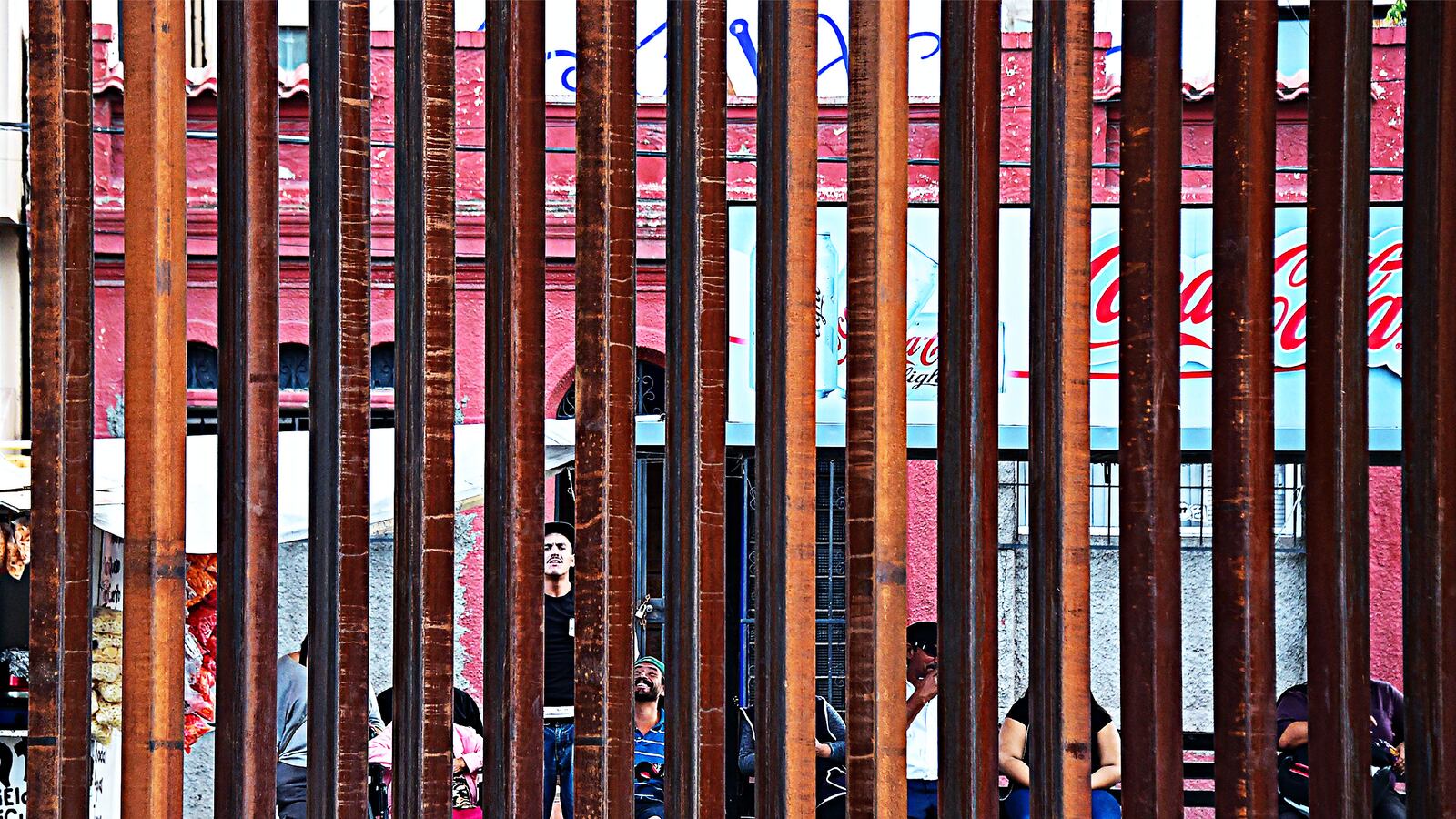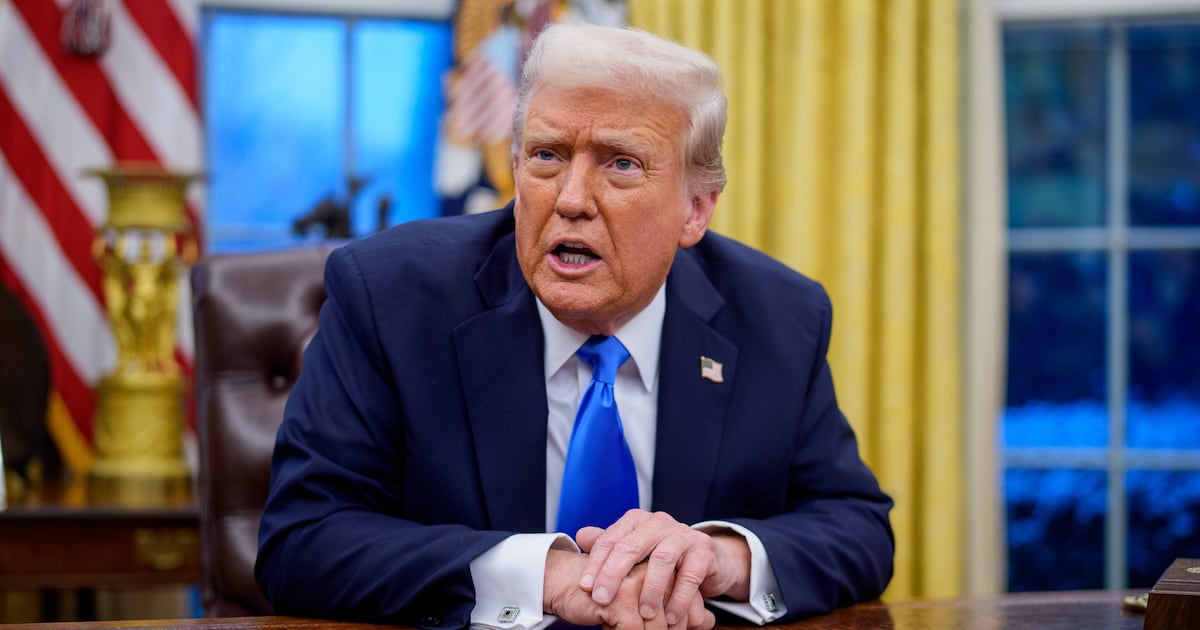NOGALES, Arizona/Sonora—A fence has cut through the border city of Nogales for decades, dividing the Arizona side of town from its more sprawling Mexican neighbor.
“At one time, it was very friendly,” says Tony Estrada, sheriff of Santa Cruz County in southern Arizona. “The fence was made of chain link. It had gaps and holes.” But a surge of drug-running and illegal immigration during the early 1990s convinced the federal government to strengthen the fence with dark, steel-mesh landing mats used by the U.S. military to improvise airstrips during wartime.
The Border Patrol installed some of these surplus mats edgewise along the border to create a tighter, darker fence. This barrier foiled some aggressive smuggling but failed to take into account “our neighbors across the line,” says Estrada, meaning Mexicans in Nogales, who found it ugly and disrespectful. Members of smuggling cartels learned to cut the mesh mats with acetylene torches.
“They would cut out squares and use ’em for barbecue grills,” Estrada says.
The Border Patrol reinforced the fence again after 2006 using tall prison-like bars ranged four inches apart, which let in light and shadow and eventually rusted brown. They became the popular image of the barrier (or one version of it) that President Donald Trump would like to build along all 1,989 miles of America’s southern border, from the Pacific to the Gulf of Mexico.
Right now this firm steel fencing divides Nogales and stretches a few miles east and west of town. “Part of the plan by the government was to move the smugglers into more difficult areas,” says Estrada. Migrants and drug mules would have to steer out to vast stretches of desert or hilly, rugged, discouraging terrain, in the hope—as another Arizona sheriff, Mark Dannels, put it before a Senate committee in 2015—“that these cartel organizations and smuggling groups would be deterred.”
They were not, and one reason they weren’t has to do with the history of the region.
***
The rugged canyons west of Nogales include some of the oldest land-smuggling paths into the United States. One route from the Mexican border called Tres Bollotas Road appears on a map from 1767, according to Mary Kasulaitis, a ranch owner and onetime librarian for Arivaca, a ranchers’ hamlet about an hour northwest of Nogales with about 650 residents.
“We have trails here that date back to the Native Americans,” says Kasulaitis. “Through Sycamore Canyon there’s a special trail that Yaqui Indians were using when they were having battles with the Mexican government.” That was around the turn of the 20th century. “In those days the United States government was supporting the Yaquis against the Mexican government.”
Mexican smugglers, in particular the Sinaloa Cartel developed by recently extradited “El Chapo” Guzmán, now use the same canyons to move migrants and drugs.
A four-strand barbed-wire fence blocks this smuggler’s highway after the steel rods protecting Nogales dribble to an end. The barbed-wire fence, says Kasulaitis, is “maintained by the ranchers, not by the government. They maintain the water, they maintain the fence, and the government does not do very much maintaining at all.”
During the day, ranchers and hunters and campers can wander these hills in the Coronado National Forest without much harassment. At night, the smugglers move.
Kasulaitis has met weary migrants from Honduras and El Salvador on her ranch, and other owners have dealt with property theft, cut water lines, even shootings by cartel scouts.
“What we have down in here is mostly drug trafficking,” says Kasulaitis. “Very well-organized, run by the cartels. If you don’t see them, or if you don’t pay attention to them, you’re fine. Don’t be out there at night. But as a rule they don’t want any trouble. They just wanna get that load through. That took some time to work out, through the 2000s.”
***
The early 2000s were a violent time in southern Arizona. Cartel snipers took occasional shots at Border Patrol agents and anyone who seemed to get in their way. Migrants stole water and food from ranchers.
In Cochise County, east of Nogales, in 2010 a rancher named Rob Krentz died of gunshot wounds on his own ranch, reportedly while he tried to help an undocumented worker. A day earlier Krentz had told the Border Patrol about a group of drug mules, and his information led to the arrest of eight Mexicans and the seizure of 200 pounds of marijuana.
His family found him with a 9mm bullet hole through each lung. The gunman has never been found.
In the Buenos Aires National Refuge, a protected swath of semi-desert near a border hamlet called Sásabe, west of Nogales, illegal immigrants used to leave piles of trash while they waited for off-road trucks to pick them up on the American side of the border. The trucks, at night, would rip up the land.
Mary Kasulaitis mentions a smuggling trail near a ranch on the Refuge. The original owners had trouble from smugglers, she says, and sold the property to the Refuge. “The Refuge tried to put staff people in the buildings, and they had trouble. Then the government fenced the Refuge, and they still had the same trouble. Because it’s on a trail. There are real smuggling trails here,” she says, “and those trails are really fixed.”
Ruby Road, a partially paved route between Nogales and Arivaca, cuts across the trails. It leads through a miners’ ghost town called Ruby and long miles of yellowish hill country, past bursts of agave, winter-blackened mesquite, and occasional Mexican graves. The signs give distances in kilometers because the road is so close to Mexico, and there’s tension day and night between the U.S. Border Patrol and the Sinaloa cartel. Both groups patrol the canyons; both have well-equipped scouts north of the Mexican line.
“One morning the sun came up and hit something shiny on a mountain,” says Kasulaitis, whose family ranch lies near the Ruby Road. “I didn’t know what it was, but I called the Border Patrol. I said, ‘Either it’s yours or it’s theirs, but I thought you oughta know about it.’”
***
Charles Bowden, a journalist and author who was a stark voice of the border before he died in 2014, showed how the drug trade was tangled up with U.S. finance and Mexican political power in his terrifying 2002 book Down By the River. Mary Martha Miles, his longtime partner and literary executor, lives in Tucson. Together they spent a lot of time in southern Arizona, and she remembers one night in about 2007, when Bowden parked their truck along a smuggling route in the Refuge, cut the lights, and waited. He made sure it wasn’t pointed toward the border and didn’t resemble an official enforcement vehicle. “He said, ‘Just watch,’ and after a while streams of people came flowing around us, walking north,” says Miles. “None of them bothered us.”
The streams of migration have slowed to a trickle since 2008, but not because of steel barriers or barbed-wire fences. “After we tanked [economically] in 2008, there was no work,” says Miles. “Before that we had landscaping, hotel jobs, construction. But that completely left [Arizona] with the recession. All the work is gone.”
The exception is farm work, which is seasonal but reliable. Ranchers in southern Arizona know this market dynamic better than most people in America. They also know the canyons traversing Ruby Road have been used across centuries for cattle raids, Indian wars, contraband including alcohol (during Prohibition), and now heroin and cocaine, not to mention illegal labor. The stories are alarming. But “for most people that live here,” says Kasulaitis, a bit surprisingly, after all her hard-eyed assessments, “it’s not a problem.”
Sheriff Estrada, in Nogales, agrees that the border violence is easy to exaggerate. “It’s completely overblown,” he says. His county, Santa Cruz, which includes Nogales as well as Arivaca, “hasn’t seen any homicides in five years,” he says. “In Nogales itself, it’s been six years.”
***
More than 700 miles of rusted steel rods now stand along the Mexican border, like a dashed line, to guard urban areas near San Diego, Yuma, Nogales, El Paso, Laredo, and Brownsville, as well as protected land like the Buenos Aires National Refuge. They’ve done some good. The fencing has reduced property crime in the border towns and ended some of the worst garbage and off-road vehicle damage in the Refuge. (“It helped a lot!” Kasulaitis says of the fencing there.)
But a border-long barrier strikes many people in southern Arizona as a costly distraction, and Trump’s estimate of $8-12 billion to build a concrete wall is almost certainly a low-ball figure. The MIT Technology Review last fall calculated that 1,000 miles of concrete would cost $38 billion just to build. Either price counts only construction—not hiring extra border agents or maintaining the barrier over its useful lifespan (which, in the case of the steel rods, is about 25 years).
The Mexicans who are supposed to pay for the barrier, according to Trump’s campaign promises and reassertions as president, find the whole thing laughable. Former Mexican President Vicente Fox is a prominent businessman, the sort of guy who might be taxed under Trump’s notion of a “one-time payment” to finance the project. He famously tweeted at the president-elect in early January: “TRUMP, when will you understand that I am not paying for that fucken wall. Be clear with US tax payers. They will pay for it.”
The current president, Enrique Peña Nieto, has cancelled a meeting with Trump to emphasize that Mexico would not pay for the vague construction project that Trump just set in motion. On Friday they talked on the phone, but it’s doubtful they reached any agreement.
The point to many southern Arizonans is that a 1,989-mile barrier might not even work. The cartels can build tunnels. Their acetylene torches can cut down the present-day rods. Gaps appeared in the first stretches of steel-rod fence in remote parts of New Mexico and Texas shortly after they went up in 2007, cut with acetylene and plasma torches, hacksaws, and other high-powered tools, according to news reports at the time.
“I don’t think a big fence is gonna stop anything,” says Mary Kasulaitis, “unless they have a guard tower every quarter of a mile and people staffing it.”
No monumental idea is out of the question with President Trump; but a border wall with guard towers would be a fantastically expensive, Berlin-Wall nightmare, a dark vision of full militarization in what used to be the free American West.
“It’s not ever gonna happen,” Kasulaitis predicts, because of the expense. “Particularly when, you know, politically speaking, there are so many people who want that cheap labor, without [paying for medical] benefits. Or as long as we are the market for drugs. That is the issue.” Basic economics, she says: “We have the demand,” in America. “And the cartels fulfill it.”






